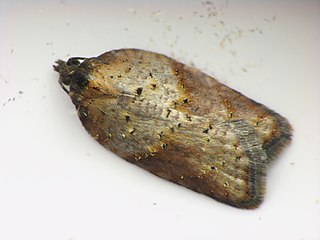
The Tortricidae are a family of moths, commonly known as tortrix moths or leafroller moths, in the order Lepidoptera. This large family has over 11,000 species described, and is the sole member of the superfamily Tortricoidea, although the genus Heliocosma is sometimes placed within this superfamily. Many of these are economically important pests. Olethreutidae is a junior synonym. The typical resting posture is with the wings folded back, producing a rather rounded profile.

The Archipini are a tribe of tortrix moths. Since many genera of these are not yet assigned to tribes, the genus list presented here is provisional.
Asterolepis is a genus of moths belonging to the subfamily Tortricinae of the family Tortricidae.
Ericodesma is a genus of moths belonging to the subfamily Tortricinae of the family Tortricidae.
Paraphyas is a genus of moths belonging to the subfamily Tortricinae of the family Tortricidae. It contains only one species, Paraphyas callixena, which is found in Australia, where it has been recorded from Western Australia and Tasmania. The habitat consists of wet sclerophyll forests.

The Tortricini are a tribe of tortrix moths.
Ericodesma leptosticha is a species of moth of the family Tortricidae. It is found in Australia, where it has been recorded from New South Wales.
Epiphyas aulacana is a species of moth of the family Tortricidae. It is found in Australia, where it has been recorded from Lord Howe Island, New South Wales, South Australia, Victoria and Tasmania. The habitat consists of open forests where it has been recorded at altitudes between sea level and 300 meters in Tasmania.
Ericodesma concordana is a species of moth of the family Tortricidae. It is found in Australia, where it has been recorded from New South Wales, the Australian Capital Territory and Tasmania. The habitat consists of open forests and heathland.
Ericodesma adoxodes is a species of moth of the family Tortricidae. It is found in Australia, where it has been recorded from Tasmania. The habitat consists of rainforests and mixed forests at altitudes between 200 and 1,000 meters.
Ericodesma indigestana is a species of moth of the family Tortricidae. It is found in Australia, where it has been recorded from New South Wales, Victoria and Tasmania. The habitat consists of heathland and open treeless areas.
Ericodesma liquidana is a species of moth of the family Tortricidae. It is found in Australia, where it has been recorded from New South Wales and Tasmania. The habitat consists of open woodland and heathland.
Ericodesma isochroa is a species of moth of the family Tortricidae. It is found in Australia, where it has been recorded from Western Australia.
Ericodesma pallida is a species of moth of the family Tortricidae. It is found in Australia, where it has been recorded from Western Australia.
Ericodesma spodophanes is a species of moth of the family Tortricidae. It is found in Australia, where it has been recorded from Victoria.
Ericodesma argentosa is a species of moth of the family Tortricidae. It is found in New Zealand.

Ericodesma cuneata, the Corokia leafroller moth, is a species of moth in the family Tortricidae. It is endemic to New Zealand. This moth is classified as "At Risk, Naturally Uncommon" by the Department of Conservation.

Ericodesma melanosperma is a species of moth of the family Tortricidae. It is found in New Zealand.

Ericodesma scruposa, also known as the Gleichenia ugly nestmaker, is a species of moth of the family Tortricidae. It is found in New Zealand.
Syllomatia pirastis is a species of moth of the family Tortricidae. It is found in Australia, where it has been recorded from South Australia and Tasmania. The habitat consists of open forests.





